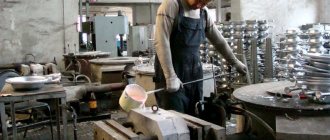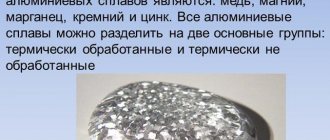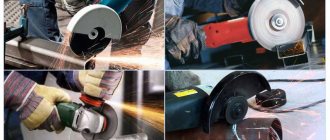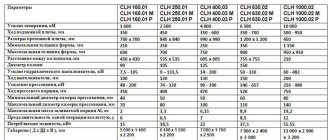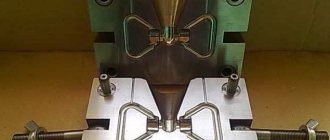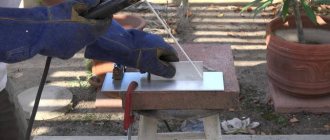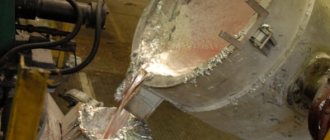Aluminum has been used in everyday life and industry for many years.
Thanks to its properties, a variety of products can be made from it. It is possible to melt aluminum at home, since it does not require high temperatures. To carry out such a procedure, you only need to know the properties of the metal.
After reading the article, you will learn how to melt aluminum at home - step-by-step instructions.
- 1 Characteristics
- 2 Details 2.1 Technological process - video instructions
- 2.2 Heat sources used
- 2.3 Making a mold for casting - instructions
Characteristic
The melting point of materials is determined by their purity. Due to its lightness and good ductility, aluminum is suitable for various technological procedures. Under the influence of high temperatures, a reaction with oxygen occurs.
An oxide film appears on the surface of the metal, protecting it from oxidation and corrosion. During melting, aluminum changes its structure, so it needs a protective coating. With sudden cooling, additional internal stress and shrinkage appear.
Melting aluminum at home step by step instructions
Aluminum and its alloys are used in almost all areas of industry, as well as in the manufacturing of household items.
At room temperature, a thin film of oxide (A12O3) forms on aluminum, firmly protecting it from subsequent oxidation. The oxidation time of aluminum increases sharply with increasing temperature.
It is for this reason that in the process of melting aluminum and its alloys in melting furnaces, the surface of the melted material and the mirror of the bath are very quickly covered with an oxide film.
Details
Technological process - video instructions
A refractory container (crucible) is used to heat the metal.
Products are used from materials such as steel, porcelain, corundum, cast iron. At home, a container made of a wide iron pipe or a ready-made crucible is used. To make it, you only need a grinder and a welding machine. The volume of the crucible can be different and is selected individually; it heats up evenly. The metal must be crushed and melted during heat transfer. The melting point must be reduced before heat treatment in order for the state of the metal to change more quickly. To do this, it is crushed into small parts. This is often followed by oxidation or combustion. Aluminum oxide is formed, which changes its state at higher temperatures. This substance is removed after remelting the metal along with the rest of the slag.
REFERENCE! When melting aluminum at home, you must avoid getting liquid into the crucible. This is because the evaporation of water can cause an explosion. Therefore, before lowering the metal into the crucible, you need to make sure it is completely dry.
Mostly aluminum wire is melted. To do this, it is divided into pieces with scissors, and then compressed with pliers. This method prevents the metal from being exposed to oxygen. If you do not plan to obtain high-quality parts, then grinding raw materials is not necessary.
If you need to produce molten aluminum at home, you will have to model the casting technology yourself. The material must first be cleaned of dirt, slag and impurities. Large workpieces must be divided into several small ones. Casting is carried out according to the instructions; the most convenient option is used for melting. Slag must be removed from the surface of the fluid substance. Molten aluminum is poured into a mold, which must be broken after the metal has solidified.
Heat sources used
In order to melt aluminum at home, you can use:
- Melting aluminum in a muffle furnace, which can be done independently. This method is very effective and allows you to quickly convert the metal into liquid form.
- Blowtorch. It can be used to melt small amounts of aluminum.
- Torch - rarely used.
The hearth is made of bricks, and the frame is made of a metal container. On one side, a drill is used to make a hole for oxygen supply. A hair dryer, vacuum cleaner or other similar device is connected to a metal tube. The crucible is placed in the hearth after the fire has been lit. For better heat treatment, the coals can also be placed on the sides. To avoid losing heat, you can make a lid, leaving a hole for the smoke to escape. It is not worth making a furnace if the metal needs to be melted only once.
Melting aluminum on a gas stove also takes place. An ordinary gas stove can heat metal to the required temperature. Small pieces of aluminum will melt in about half an hour.
A tin can is usually used as a crucible. The jar is placed in another jar so that the gap between the two is about one centimeter. This is necessary for uniform temperature distribution. In the larger jar, you need to make several holes to provide fire access. The diameter of these holes should be 3-4 cm in diameter. In this case, the divider on the burner does not need to be removed. In this way, you can achieve uniform heating of the aluminum can. The larger jar is covered with a lid to prevent heat from escaping.
Making a mold for casting - instructions
If you need to do something simple, then making a special mold is not required; the metal can be poured onto a steel sheet.
If the product is more complex, then you need a mold that can be made from the following materials:
- - clay;
- - plaster;
- - liquid glass;
- - sand;
- - coal ash.
There are two ways to pour the alloy into a mold - open and closed.
Open is the easy way. The metal that has been melted is poured into an ordinary container, cup, tin can, and so on. After the alloy has cooled, the blank is removed from the container. If it doesn't matter what shape the metal object will be, leave the aluminum on a durable surface.
Forming elements are used for complex castings, when the product must meet specified parameters. In open pouring, silica is often used. The item is made from two containers containing compacted earth. The silica pieces are compressed and a casting model is placed between them. This way you get a clear imprint of the desired part. The model is removed, and hot aluminum is poured into the mold. With the closed casting method, river sand is taken and mixed with liquid glass.
For one-time casting, you can use plaster. Models are made from foam plastic or paraffin.
IMPORTANT! The use of these materials is only possible in an open space with good air access.
The foam is not removed from solid plaster, but is filled with molten aluminum. Its combustion products are harmful to human health.
MELTING ALUMINUM ALLOYS Chapter 1
2>
Aluminum alloy castings occupy a leading position in non-ferrous casting. Their share in the total production of castings from non-ferrous alloys reaches 75%. In this regard, when developing technology for melting aluminum alloys, it is necessary to achieve maximum efficiency of processes, reducing the cost of metal, labor and energy per ton of suitable castings.
The development of technology for melting and casting aluminum alloys is carried out taking into account the physical and chemical characteristics of the interaction of all solid, liquid and gaseous phases involved in the melting process.
3.1. Physico-chemical features of smelting
Aluminum has a low density (2.7 g/cm3) and a low melting point (660 °C).
Among the physical properties of aluminum, high heat capacity, thermal conductivity and latent heat of fusion should be noted. In this regard, melting aluminum and its alloys is a rather energy-intensive operation. The amount of heat required to heat and melt 1 kg of aluminum (660 °C) is comparable to the heat spent on melting the same amount of cast iron (1250 °C). The low electrical resistivity of aluminum reduces the thermal efficiency of induction furnaces.
The melting process of aluminum alloys is accelerated when the charge is immersed in the melt, when, simultaneously with the heating of the charge, it dissolves in the melt. The difficulty of dissolving other more refractory elements in aluminum necessitates the use of alloys.
The main difficulties during melting are caused by the increased chemical activity of aluminum, especially its high affinity for oxygen. Aluminum and its alloys are prone to interaction with furnace atmosphere gases, refractory materials and fluxes.
When melted in air, aluminum alloys oxidize, and a dense, durable film of A1203 with a thickness of 0.1 to 10 microns is formed on the surface of solid and liquid aluminum, depending on time and temperature. The main oxidizing agents are air oxygen and water vapor.
The kinetics of further interaction will depend on the ratio of the volumes of oxide (Vmeo) and metal (Vme) spent on its formation. Below are the specified ratios for some metals:
| Oxide | MgO | Al2O3 | BeO | ZnО | Fe2O3 | Fe3O4 |
| Vmeo/Vme | 0,75 | 1,14 | 1,67 | 1,46 | 2,14 | 2,09 |
If the volume of the oxide is less than the volume of the metal (Vmeo/Vme <1), then the oxide layer will be loose, friable, and capable of freely passing gas to the surface of the metal. The interaction of oxygen with such a metal (Mg) will occur at a constant speed or even increase. If the volume of the oxide is greater than the volume of the metal (Vmeo/Vme >1), then the oxide film becomes dense and at a certain thickness the access of oxygen to the reaction zone stops. Just such protective oxide films are formed on the surface of aluminum and aluminum alloys.
Most alloying elements (Cu, Si, Mn) do not have a significant effect on the oxidation process and the protective properties of the oxide film. At normal concentrations of these elements in alloys, the oxide film consists only of Al2O3. Oxidability increases under the influence of alkali and alkaline earth metals (K, Na, Li, Ca, Sr, Mg) and Zn. With their participation, loose oxide films are formed. Thus, with a Mg content of more than 1%, the oxide film consists almost entirely of MgO, which does not have protective properties. Beryllium and lanthanum (up to 0.01%) reduce the oxidation of such alloys. The oxidation of aluminum can also be reduced by adding gaseous fluoride compounds SiF4, BF3, SiF6, etc. to the atmosphere (up to 0.1%). Fluorides are adsorbed on the surface of the oxide film and reduce the rate of oxygen penetration into the metal.
The introduction of additional portions of the charge into the melt, mixing of the melt during the melting process, and scooping up the alloy with a ladle during casting disrupt the continuity of the protective oxide film. It is inevitably mixed into the melt, and remains suspended for a long time, and a new one appears in its place.
Aluminum is a good reducing agent for the oxides of most metals, which makes it difficult to choose a refractory material for lining melting furnaces. Due to the reducing effect of aluminum in relation to the melting and lining materials, oxides are also formed in the bulk of the alloy. The most significant influence on the degree of contamination of the melt with oxides is exerted by the surface oxidation of the charge materials. The finer the charge, the larger the specific surface of the charge and the higher the degree of contamination of the alloy with oxides.
In addition to oxygen, aluminum can react chemically with nitrogen and carbon to form nitrides and carbides. Thus, in addition to Al2O3 and MgO oxides, the melt may contain aluminum, magnesium and titanium nitrides (AlN, TiN, Mg3N2) and Al4C3 carbide. These compounds are found in the melt in the form of dispersed particles with sizes of 0.03 - 0.5 microns, evenly distributed throughout the entire volume. Despite the difference in density, they separate very slowly from the melt. Oxide films are larger with a thickness of 0.1 - 1.0 microns, and a length of up to several mm. When the alloy sits, large inclusions should settle to the bottom or float to the surface, but this process proceeds slowly. Thus, when filling molds with aluminum melt, there is always a high probability of film and fine non-metallic inclusions getting into the casting. This leads to the formation of discontinuities, a decrease in mechanical properties and the appearance of corrosion areas.
Molten aluminum and aluminum alloys dissolve hydrogen, the content of which can reach up to 1.0 – 1.5 cm3/100 g.
The gas content of a metal can be expressed as a percentage by mass, as an atomic percentage, or as the volume of hydrogen dissolved in 100 g of metal (cm3/100 g). In the latter case, it is assumed that all dissolved hydrogen is separated from the solution and is in a molecular state under normal conditions: Рн2 = 105 Pa, T = 273.15 K. The units of measurement are recalculated taking into account Avogadro’s law, according to which under normal conditions 1 mole of gas occupies a volume of 22,413 cm3. The mass of 1 mole of hydrogen is 2 g. Thus, if the hydrogen content is 0.0001% by mass, then 100 g of metal will contain 0.0001 g of hydrogen. Its volume x can be found from the proportion: 2: 22,413 = 0.0001: x. From here we find x = 1.12 cm3, i.e. 1 cm3/100 g @ 0.0001%.
The main source of hydrogen is water vapor, the partial pressure of which in the furnace atmosphere can reach 8–16 kPa. When molten aluminum comes into contact with moisture, the following reaction occurs:
2 Al + 3 H2O = Al2O3 + 6 [H] Me.
Hydrogen in atomic form dissolves in the metal, and oxygen forms an oxide that is insoluble in the melt.
Moisture is contained in the charge materials to be melted, in fluxes, in the fresh lining of furnaces and ladles, and is adsorbed on the melting tool. The oxide film on charge materials stored in damp rooms contains aluminum hydroxide Al(OH)3. Chemically bound moisture is poorly removed from the surface of charge materials even at 900 °C. In this regard, it is necessary to store waste and returns in such a way as to prevent their oxidation and corrosion. It is advisable to pre-melt small waste with a developed surface. Hydrocarbons of liquid and gaseous fuels, for example, methane, also serve as a source of hydrogen supply to the melt.
As is known, the influence of dissolved hydrogen on the quality of a casting is assessed not by its quantity in the liquid metal, but by the so-called coefficient of potential supersaturation of the metal with hydrogen during crystallization n, which is determined from the ratio:
n = (H Me.f – HMe.sol) / HMe.sol.
The greater the numerical value of this coefficient, the greater the tendency of the metal to form gas defects due to a decrease in gas solubility during solidification. The solubility of hydrogen in aluminum is less than in other metals. Despite this, aluminum is most susceptible to the formation of gas porosity, since it has the highest value of the potential supersaturation coefficient (n = 13). In solid aluminum, the solubility of hydrogen is only 0.05 cm3/100 g, so it will be released from the liquid solution more intensely than from other metals.
The interaction of hydrogen not with pure aluminum, but with alloys based on it, is determined by their composition. If the alloy contains components that have a higher gas solubility than the base, then the solubility of the gas in the alloy will increase and vice versa. For example, in aluminum alloys containing magnesium, the solubility of hydrogen is greater than in aluminum or aluminum-copper alloys.
The listed features of aluminum alloys indicate the need to protect the melt from contact with the atmosphere and carry out thorough refining or degassing of the melt.
3.2. Technological features of melting
Knowledge of the listed physical and chemical features of aluminum allows you to draw up a general scheme of the smelting process: select a melting unit, charge materials, methods of refining and modifying the melt, set the smelting temperature
3.2.1. Furnaces for melting aluminum alloys
The choice of furnace type is made depending on the scale of production, the nature of casting (requirements for casting quality) and energy capabilities. Melting of aluminum alloys can be carried out in a variety of electric and fuel furnaces.
Fuel furnaces can be crucible, reverberatory and shaft-bath furnaces. The greatest use for aluminum alloys is found in crucible and bath furnaces using gas and liquid fuel.
For small production volumes, it is convenient to use crucible rotary furnaces with oil or gas heating. In them you can easily switch from preparing one alloy to another, carry out refining and modification. In these furnaces, minimal metal loss occurs (0.5 - 1.0%). Disadvantages include low thermal efficiency and the need for frequent replacement of crucibles. Crucible fuel furnaces (Fig. 10) consist of the following elements: a metal body 1, burners or nozzles 2 and a melting crucible 3. The furnace body is protected by a heat-insulating layer and refractory masonry. An exhaust hood is installed above the stove to remove flue gases. To drain the metal, the body has a manual rotating device.
Crucible fuel furnaces are also used for melting magnesium, copper, zinc and other alloys.
Among the electric furnaces suitable for melting aluminum alloys are crucible or reverberatory electric resistance furnaces) and induction furnaces.
Crucible resistance furnaces of the CAT type (Fig. 11, a) are used for melting small quantities (up to 250 kg) of aluminum alloys. Most often they are used as melting and dispensing units to maintain the temperature of the metal during casting into molds. SAT furnace heaters are made from nichrome wire.
In chamber reverberatory furnaces of the SAK type (Fig. 11, b) with a capacity of up to 650 kg, heating elements made of nichrome or carborundum are installed in the furnace roof. The metal is dismantled through the working window. The charge is loaded from the opposite side.
Rice. 10. Rotary crucible furnace
Electric furnaces of the SAN type (Fig. 11, c) are the most metal-intensive (up to 3000 kg). They have a tilt mechanism to drain metal through the drain sock. Heaters are made of nichrome wire. These furnaces are highly efficient. They are economically advantageous to use in large-scale and mass production, as well as in waste remelting. Finishing and refining of alloys is carried out in small-capacity holding furnaces.
The most progressive method of melting aluminum alloys in foundries with mass production is induction heating with industrial, medium and high frequency currents. For aluminum alloys, open induction crucible furnaces are most suitable. They have the following advantages:
1. high performance;
2. intensive circulation of the melt in the crucible, ensuring equalization of temperature and chemical composition throughout the entire volume of the bath;
3. the ability to carry out melting at any pressure (from atmospheric to vacuum) and in any atmosphere (oxidizing, reducing or neutral);
4. simplicity and convenience of furnace maintenance, control and regulation of the smelting process;
5. good sanitary and hygienic working conditions.
Rice. 11. Electric resistance furnaces for melting aluminum alloys: a – crucible furnace type CAT; b – reverberatory furnace type SAC; c – reverberatory furnace type SAN; 1 – thermocouple; 2 – cover; 3 – heaters; 4 – crucible; 5 – exhaust hood
Currently, a number of specialized domestic and foreign companies supply complete induction melting plants (IMS). Thus, the domestic group of companies RELTEC supplies installations that include: one or two induction melting furnaces (IMF), a double-circuit inductor cooling station with an ion-exchange filter, a remote control, a hydraulic drive for turning the furnace, a control system for the crucible lining and cooling water.
If the UIP includes one furnace, then the set of electrical equipment (Fig. 12) includes: a high voltage input device (HVD), a power transformer (Tr), a thyristor frequency converter (FFC) and a block of compensating capacitors (BC).
Rice. 12. Schemes for completing electrical equipment for induction melting furnaces
For a more flexible supply of liquid metal to the foundry, increasing the utilization rate of furnaces and increasing productivity, a two-station tandem melting scheme can be implemented. In this case, the UIP includes two furnaces. There are three options for power supply for tandem smelting. The simplest of them provides one TPChP and an additional power switching device (SPU). When the melt is prepared in one furnace, the power supply is switched to the second furnace. Such a system helps reduce UIP downtime, and productivity increases slightly.
More productive operation of the UIS is achieved in the presence of a second low-power TCFC of no more than 10% of the main channel or when using two-channel frequency converters, which additionally include chokes (DR) and inverters (I).
Modern UIPs allow you to automate the melting process and conduct statistical processing of melting process parameters. For this purpose, it is possible to constantly accurately weigh the melt in the furnace at any stage of operation, and therefore to regulate the chemical composition and take into account the loaded charge and fused metal.
The furnaces included in the UIP can have a capacity from several kilograms to several tons. Regardless of the capacity, induction crucible furnaces have the same structural components and differ in electrical power and productivity. In Fig. Figure 13 shows an IAT-2.5 furnace with a capacity of 2.5 tons.
Due to the high chemical activity of the aluminum melt, great importance is given to materials for linings and crucibles.
The lining of reverberatory furnaces is made of magnesite or fireclay. To reduce interaction with the melt, the lining is covered with a coating of flux (23 - 25% Na3AlF6, 20 - 27% B2O3, remainder NaCl) mixed with liquid clay. The coating is calcined at 900 – 950 °C.
Crucibles for melting aluminum alloys are made of gray or alloy cast iron. You can also use graphite chamotte crucibles designed for melting copper and copper alloys. Their capacity is from 0.5 to 500 marks. The conventional unit of capacity - brand, shows the volume occupied by 1 kg of molten copper. Knowing the densities of copper and alloy, you can determine the mass of the alloy in the crucible.
Fig. 13. Induction crucible furnace IAT – 2.5 for melting aluminum alloys: 1 – magnetic cores; 2 – inductor; 3 – stuffed crucible; 4 – furnace frame; 5 – working platform; 6 – drain sock; 7 – axis of the rotary device
To protect against saturation of the melt with iron, the working surfaces of cast iron crucibles are covered with protective refractory coatings, and the entire melting tool is covered with refractory paints.
For cast iron crucibles, a coating is used consisting of (%, by weight): 17 – graphite; 18 – refractory clay; 5 – liquid glass and 60 – water. The coating is applied in a layer at least 5 mm thick
Tool paints include chalk, zinc oxide, fire clay, talc, colloidal graphite and other substances. Most often, paint is used consisting of 50 parts (by weight) of washed chalk, 50 parts of zinc oxide, 5 parts of liquid glass, 100 parts of water or paint of 32.5 parts of washed chalk or zinc oxide, 1.5 parts of liquid glass and 66 h water. The paint is applied to surfaces heated to 90 - 150 oC using a sprayer or a brush.
It is recommended that induction crucible furnaces for aluminum alloys be lined with heat-resistant concrete. Concrete based on liquid glass with sodium fluoride has proven itself well. They have the following composition,%: 28.8 - finely ground magnesite; 25.0 - fireclay chips measuring 0.15 - 0.50 mm; 30.0 – fireclay chips measuring 5 – 10 mm; 15 – liquid glass with a density of 1.36 – 1.38 and 1.2 – sodium silicofluoride. Heat-resistant concrete acquires high strength after firing at temperatures above 800 °C.
3.2.2. Selection and preparation of charge materials
Primary and secondary metals and alloys, alloys, return and waste are used as initial charge materials. The ratio of these materials depends on the purpose of the castings. The higher the requirements for their quality, the greater the share of primary materials. The main attention is paid to the content of impurities. For ordinary castings, primary aluminum of technical purity grades from A0 to A85 is usually used. For critical-use castings – high-purity aluminum A99 or A995. To introduce all alloying additives, it is necessary to use master alloys, the composition of which is given in table. 2. In its pure form, only zinc of grades Ts1, Ts2 and magnesium of grades Mg90, Mg95, Mg96, the melting point of which is lower than that of pure aluminum, can be introduced. If necessary, you can order any primary aluminum alloy with a specified impurity content. The cheapest components of the charge are secondary pig alloys and own waste.
Charge materials for melting aluminum alloys, as well as fluxes, refining and modifying materials must be stored in a specially equipped dry room - a warehouse for charge materials separately by grade. Own waste and returns are cleaned of sand in cleaning devices along with castings and marked with a melt mark or paints. Small waste and shavings, as well as waste contaminated with oil and emulsion, must be melted down and stored in the form of marked pigs.
Before loading into the molten metal, all components of the charge must be heated to 150–200 °C on board the furnace to avoid metal emissions.
3.2.3. Protection against oxidation and gassing
To protect against oxidation and saturation with hydrogen, smelting can be carried out in a vacuum, under a protective atmosphere of inert or neutral gases, in an air environment containing fluorides, and under coating fluxes. If during melting priority is given to protection from hydrogen saturation, then melting is used under a weakly oxidizing atmosphere. In production conditions, the most common protection of the melt is coating fluxes made from a mixture of chlorides and fluorides of sodium, potassium, calcium and magnesium. The composition of some coating fluxes is given in table. 8.
Table 8.
Composition of coating fluxes for melting aluminum alloys
| Flux number | Content of components, % | Application area |
| 45 NaCl, 55 KCl | For most alloys except aluminum-magnesium | |
| 37 NaCl, 50 KCl, 6.6 Na3AlF6, 6.4 CaF2 | Same | |
| 42-46 NaCl, 43-47 KCL, 7-15 Na3AlF6 | For wrought alloys, except aluminum-magnesium | |
| 100 MgCl2×KCl | For aluminum-magnesium alloys | |
| 85 MgCl2×KCl, 15 CaF2 | Same | |
| 85 MgCl2×KCl, 15 MgF2 | Same |
Flux number 1 has a melting point of 650 °C and well wets the surface of the melt and aluminum oxides. Flux consumption is 1 – 2% of the charge weight. It is always used when melting in reverberatory furnaces. At high melting rates in crucible furnaces, coating flux may not be used.
For alloys containing magnesium, carnallite-based fluxes (MgCl2×KCl) are used, which wet magnesium oxide.
Despite precautions, the melt becomes more or less contaminated with metallic and nonmetallic inclusions and is saturated with hydrogen. To obtain high-quality castings, it must be refined.
3.2.4. Refining of aluminum alloys.
Purification of aluminum alloys from various inclusions and hydrogen can be carried out by settling the melt, blowing with inert and active gases, treating with chloride salts and fluxes, vacuuming and filtration.
Advocacy
based on the floating or sedimentation of inclusions due to differences in density with the melt. This difference is small, and the effectiveness of this method is also small. Even with prolonged exposure, only large particles are removed. If you keep the melt in a switched off furnace and cool the melt to the melting temperature (freeze out the melt), then you can partially remove dissolved hydrogen.
Blowing melts with gases
accompanied by the diffusion of dissolved gas (hydrogen) into the bubbles of the purged gas and the floating action of the bubbles in relation to some inclusions. They use inert (argon, helium) or neutral gases (nitrogen) and active gas - chlorine or a mixture of nitrogen and chlorine. For aluminum alloys, cheaper nitrogen is usually chosen. At temperatures up to 800 °C, nitrogen does not interact with molten aluminum, i.e. is a neutral gas with respect to aluminum. At higher temperatures, aluminum nitrides are formed.
The mechanism of refining by blowing with inert or neutral gases, in particular nitrogen, is shown in Fig. 14. Gas can be supplied to the melt using ceramic (or lined metal) tubes with porous tips (Fig. 14, a) into the melting crucible or pouring ladle, as well as through porous ceramic inserts mounted in the bottom of the ladle (Fig. 14, b ). The gas tube must be moved throughout the entire volume of the melt. Gas comes from the cylinder through a reducer. The gas pressure is increased gradually until slight bubbling appears above the melt. A desiccant filled with silica gel granules must be built into the gas supply system.
Rice. 14. Methods of blowing the melt with nitrogen through a tube with a porous tip (a) and through a porous insert (b): 1 – crucible (ladle); 2 – tube; 3 – porous insert; 4 – porous insert; 5 – casing for gas supply
In Fig. Figure 15 shows the distribution of partial pressures in a rising nitrogen bubble. Since the partial pressure of hydrogen in the newly formed bubble is zero, diffusion of hydrogen dissolved in the melt into this bubble begins, despite the fact that the nitrogen pressure in it is greater than atmospheric (otherwise it will not float up). The dissolved gas will move from the melt to the bubble until equilibrium is reached between the gas phase and the melt-solution. The larger the total surface area of the inert gas bubbles (the smaller the bubble size), the higher the degassing rate. This explains the use of porous materials with a pore diameter of no more than 0.1 - 0.5 mm when blowing.
Floating gas bubbles always have a floating effect in relation to non-metallic inclusions, which are poorly wetted by the melt (they are hydrophobic bodies). The bubbles “stick” to the surface of the inclusions. This process is energetically favorable. As a result, entire aggregates of gas bubbles and non-metallic inclusions are formed in the melt (Fig. 16). An aggregate may contain one bubble and one or more particles, or there may be several bubbles and one or more particles. As soon as the total density of such an aggregate becomes less than the density of the melt, it will rise to the surface and turn into slag.
| Rice. 15. Partial pressures of gases in a floating nitrogen bubble | Rice. 16. Aggregates of non-metallic inclusions and gas bubbles |
High results are achieved by blowing with active chlorine. Bubbles of chlorine introduced into the melt primarily interact with aluminum according to the reaction:
2 Al + 3 Cl2 = 2 AlCl3
Aluminum chloride (boiling point 180 °C) instantly turns into steam and forms additional gas bubbles. Some of the chlorine reacts with dissolved hydrogen:
Cl2 + 2 H = 2 HCl
Hydrogen chloride is also in a vapor state. Bubbles of AlCl3 and HCl will float to the surface. Since the partial pressure of hydrogen in them at the initial moment is zero, hydrogen dissolved in the metal, due to the difference in partial pressures, will diffuse into the bubbles of refining gases. Just as when using an inert or neutral gas, this process will continue until the partial pressures of hydrogen in the melt and in the gas bubble are equal.
If solid particles wetted by gas are encountered along the path of gas bubbles, they will also float to the surface of the melt.
Chlorine consumption is 0.3 - 0.5 m3 per ton of alloy, the duration of purging at 710 - 730 °C can be 10 - 12 minutes. The chlorine pressure is maintained at 0.11 - 0.12 MPa, at which slight bubbling is observed on the surface of the melt. Chlorine treatment is carried out in sealed chambers or in buckets with a lid connected to a ventilation system.
Chlorine is a toxic gas, so occupational safety precautions must be carefully observed. For this reason, chlorine blowing is currently practically not used in production.
Blowing with nitrogen or argon is carried out at 720 – 730 °C for 5-20 minutes. The consumption of these gases is 0.5 - 1.0 m3 per ton of alloy. The effectiveness of the method increases if the blowing is carried out through porous ceramic inserts. The smaller the size of the bubbles of the purged gas and the more uniform the distribution throughout the volume of the melt, the purer the melt.
It is more expedient to blow the melt with gases when melting in crucible furnaces. In reverberatory furnaces, the bath depth is small and bubbles rise to the surface very quickly.
Treatment with chloride layers
accompanied by exchange reactions with the melt. Zinc and manganese chlorides will be used (0.05-0.2% at a temperature of 700 - 730 °C), hexachloroethane C2Cl6 (0.3 - 0.7% at a temperature of 740 - 750 °C), as well as TiCl4, and other chlorides . When reactions occur
3 TiCl4 + 4 Al = 4 AlCl3 + 3 Ti
3ZnCl2 + 2 Al = 2 AlCl3 + 3 Zn
3MnCl2 + 2 Al 2 AlCl3 + 3 Mn
gaseous reaction products (AlCl3) are formed, which have a refining effect, as when blowing with gases.
Inorganic chloride salts are highly hygroscopic. To remove moisture, the salts are dried (MnС12) or melted (ZnСl2) and introduced into the melt using a bell in several stages. After processing, the melt is left to stand for 10-15 minutes. Prepared salts after remelting or drying must be stored in a thermostat at 120 – 150 °C. Metals reduced from salts remain in the melt. Some of them are useful and can play the role of modifiers, but for a number of alloys they can be harmful impurities.
Organic chlorides, and primarily hexachloroethane, are characterized by reduced hygroscopicity, are not scarce and have good degassing ability. Hexachloroethane C2Cl6 (a colorless crystalline substance with a sublimation temperature of 187 °C and a density of 2.1 g/cm3) gradually displaces other salts. When interacting with molten aluminum, two gaseous products are formed:
2>
Date added: 2019-05-21; views: 527; ORDER A WORK WRITING
Find out more:
Possible mistakes and ways to avoid them
Gypsum molds are very convenient and highly sensitive to moisture. Conventional drying does not remove moisture, so the quality of the casting becomes worse. To achieve complete drying of the plaster mold, you will have to wait several days. Aluminum must be heated over a fire until it is poured into the mold, so that you can then distribute it over the mold before it hardens.
Do not use water to cool the product. This is due to the fact that under the influence of water, cracks appear - the internal structure of the substance is disrupted.
Precautionary measures
To work with molten aluminum, you must use personal protective equipment. All exposed areas of the body, hands, and face must be protected.
REFERENCE! It is best to use welding gloves; they can withstand temperatures of more than 600 0 C. This means of protection is the most basic, since the possibility of molten metal getting on your hands is very high.
It is also better to use goggles and a mask to avoid hot elements coming into contact with your face and eyes. To protect the entire body, you can find a metallurgist suit that has high fire resistance. When cleaning aluminum welding flux, a chemical respirator is used.
Source
Useful tips
- The melt must be hot so that the mold is filled evenly. It is poured when it acquires the consistency of mercury.
- Castings with complex configurations are made quickly; they try to fill the molds right away so that the metal does not have time to set and no partitions or voids are formed.
- Metal can be poured into plaster over wax or foam; high temperatures cause the wax and foam to burn out. The surface of the casting will be smooth.
- To cool the casting, do not immerse it in water; the casting will crack.
- When melting pure aluminum, the technology of using protective fluxes is used; they protect the metal from oxidation.
Fire safety must be observed; the casting process involves the use of an open flame. It is important to use personal protective equipment: gloves, goggles.
Source
Before starting work
First you need to decide on the size of the product and the scope of work:
- For smaller ones, a gas stove is suitable.
- For medium-sized ones - a homemade small oven made of refractory bricks
- For larger ones - a muffle furnace.
With any choice, you need to close the container with molten aluminum as much as possible from drafts and seal the walls as much as possible to reduce heat loss. Aluminum gives off heat quickly, so it is difficult to heat it under simple conditions. Let's look at how to achieve this.
Result
Don't rush to take the metal from the barrel! He is now very hot from the contact welding machine. It’s worth going to rest and letting the metal cool. Usually three hours is more than enough for a heated metal barrel to cool down. Half a ton of raw material usually yields a quarter ton of aluminum. The metal obtained from bauxite, of course, is unlikely to be as pure as it is obtained at special ore purification plants. As a result, we will end up with a certain mixture in which the share of aluminum will be from 80% to approximately 90%. Such purity is enough to take what you receive to the nearest point where they accept non-ferrous metals and get money for it. True, of course, no one will pay the full price there, but even under this condition, it’s possible to earn about a hundred thousand rubles in a month.
The technology of chemistry that was literally on the surface is now known. In general, think about it. Are you ready to take the risk or is the usual boring everyday routine of official employment more pleasant for you than the new prospect that has opened up? Decide.
Characteristics of aluminum
It is not necessary to know all the characteristics of aluminum, but in order to know how to melt aluminum at home, you need to keep in mind some features that eliminate technological errors. In addition, during work it is necessary to exercise extreme caution due to the high risk of injury during the casting process.
At home, melting metal on a gas stove is unlikely to be possible, since the melting point of aluminum is 660.3C, and household gas appliances are not able to create the required temperature.
A decrease in the melting point of raw materials can be achieved by grinding it into powder. In addition, you can use ready-made raw materials in powder form. However, one more point must be taken into account here. Aluminum is a fairly active metal and, when interacting with oxygen contained in the air, can oxidize or even ignite. During the melting process, a small amount of oxide is formed, which contributes to the formation of scale. Another unpleasant surprise in the form of an explosion can occur when water gets into the molten metal. Therefore, when adding the necessary components, you need to make sure that they are dry.
Raw materials for smelting
If you plan to melt metal at home, you should not use powdered aluminum for melting. It is better to use aluminum wire, cut into small pieces, pressed using pliers, to reduce the area of interaction with air.
If the requirements for product quality are low , then to obtain raw materials it is permissible to use any items consisting of aluminum.
Is it possible to melt aluminum over a fire?
Aluminum is a very common metal in both industry and households. It is not uncommon that when a part breaks, there is a need to smelt a replacement.
Melting aluminum at home is attractive because it is possible at a relatively low temperature.
To carry out the operation yourself, you need to know the characteristics of the metal when exposed to temperature and its physicochemical properties.
How to cast an aluminum part at home
For many, the term “foundry” is closely associated with back-breaking labor and specialized professional skills.
In fact, casting a part from the required metal is possible for the most ordinary person without professional training at home. The process has its own subtleties, but it can be done at home with your own hands.
Outwardly it resembles the production of lead weights for fishing. Features of the aluminum casting process are related to the technical characteristics of the material.
How to cast aluminum
Characteristics of aluminum.
Aluminum is one of the most common metals.
It is silver-white in color and lends itself quite well to casting and machining. Due to its characteristics, aluminum is equipped with high thermal and electrical conductivity, and also has corrosion resistance.
Technical aluminum has a melting point of 658 degrees, high-purity aluminum has a melting point of 660, and the boiling point of aluminum is 2500 degrees.
For aluminum casting, home heating devices are unlikely to be useful and will provide the required temperature. It is necessary to melt aluminum by heating it to a temperature of over 660 degrees.
What technologies exist for melting metal?
When using a gas stove, you need to remove the existing flat nozzle and install a special device on top of the grate - a cylinder, which can be made from any iron can of a suitable size. A 3-4 cm hole is made at the bottom of the cylinder, and 3 screws are tightened - they are needed so that the mold with aluminum inside the cylinder will stand on them.
A torch will come out of the camphor and enter the cylinder and heat the mold with the metal. The cylinder is needed to save heat and maximize the concentration of the flame around the mold. It is buried on top with a plate so that the heat does not escape, but a small gap is left for traction.
The same principle is used for stoves; large containers can be placed here due to minimal heat loss and large space inside the stove. A small grill is made, on which the molds are placed, after which the oven is closed as much as possible on all sides, leaving only small holes at the bottom and top for drafting.
Processing methods
Losses when recycling aluminum are low; one old can produces almost a whole new one. This type of business brings profit and benefits to the economic and industrial sector. There are several ways to obtain aluminum from cans:
- Pressing. Sorted jars are cleaned of debris and impurities. The containers, freed from drinks and food, are cut into small pieces, and iron is removed from it using a magnet. The resulting raw materials are pressed into slabs and sent to a recycling plant. After this method, additional measures are required to clean the containers from impurities and paints.
- Transformation of aluminum into powder. This method is more effective, because thorough cleaning is done immediately. Unlike pressing, it uses multi-stage grinding and impurity removal schemes. The cost of this method is higher, because the equipment is expensive and requires large premises to accommodate it. Losses during processing using this method are low and the costs are recouped.
- By pyrolysis method. Initial stage: sorting, grinding, cleaning. The resulting elements are placed in a pyrolysis furnace and heated to 750 degrees, the melting point of aluminum is 90 degrees lower. Organic impurities burn out, the resulting pure metal is poured into molds and sent for secondary production.
- The melting point of aluminum allows you to work with it at home. To do this, you need to purchase or build your own small oven for processing. It operates on coal briquettes and will melt a can in 3-4 seconds. To construct it, you will need a heat-resistant vessel in which the coals flare up, and a crucible to accommodate the metal itself. The crucible can be made from a cut-off fire extinguisher body. An ordinary vacuum cleaner or hair dryer will help create high-quality airflow to increase the temperature. You can get a kilogram of aluminum from 90 cans.
To recycle aluminum scrap at home, you must have a fire extinguisher.
How to melt aluminum cans at home
Aluminum is a common and useful metal known for its corrosion resistance, malleability and light weight. It is safe enough for use on food and in contact with skin. It is much easier to process this metal than to refine it from its ore.
You can melt old aluminum cans to make aluminum. Pour metal into a suitable mold for making jewelry, tableware, decorations, sculptures or other metalworking project. This is a great introduction to home recycling.
Materials for melting aluminum cans
Melting jars are not difficult, but this is a project for adults because of the high temperatures involved. You will want to work in a clean, well-ventilated area. There is no need to clean the jars before they melt, as organic matter (plastic coating, residual soda, etc.) will burn during the process.
aluminum cans; a small electric stove oven (or other heat source that reaches an appropriate temperature, such as a propane torch); a steel crucible (or other metal with a melting point much higher than aluminum but lower than your oven; could be a durable stainless steel bowl or cast iron skillet); heat-resistant gloves; metal tongs; the shapes you will pour the aluminum into (steel, iron, etc. - be creative);
Required Components
Here's a list of things:
- graphite powder
- metal barrel
- welding machine
- concrete mixer
- bauxite clay
Today, the above, with the exception of bauxite, can easily be found among hardware markets and building materials stores. So let's move on from idle theorizing to the practice of this technology. True, to start you need to find a place where you will get the required raw materials. Drive a car there that can transport loads weighing half a ton. This is exactly the amount of bauxite to be collected. There is no point in taking less than five centners. When stacking bauxite, consider your strength. Now take what you have collected.
A muffle furnace is an ideal home option for frequent work
A muffle furnace is similar to a simple “potbelly stove” only with thick walls. It can be either wood- or electric-powered, depending on your convenience. In the second case, the wire is stretched in a spiral from the inside of the bricks, closer to the mold.
Inside in the middle there is a crucible - a special container for melting metal. In this design, losses are minimized - the free space is occupied by the crucible, with a small gap of 5-10 cm remaining between it and the walls.
Due to the large thickness - 20-30 cm, the walls can be filled with various heat insulators to retain heat. It can be moved or made stationary, and therefore a heat insulator is selected. There is brick inside, iron outside, and how to fill the rest of the space is left to the discretion of each individual.
Metal smelting
When melting, it is important to use clean dishes (made of iron or non-ferrous metal). If you are melting it for the first time, it makes sense for further preparation. You need to clean the container, remove rust and debris, dust, rinse thoroughly, let it dry, and only then can it be used.
During cooking, remove floating slag - paint residues or dirt; they will significantly reduce the quality of the metal. After the metal has melted well, it needs to cool a little so that there is less splashing and it is more convenient to pour into molds. The latter should not be damp, so that evaporating moisture does not create bubbles in the product.
Materials for casting molds
With the open pouring method, the simplest material that is always at hand is often used, this is silica. First, the earth is laid with layer-by-layer compaction. A casting model is placed between the layers, which, after careful compaction, leaves an imprint in the silica. This mold is carefully removed and aluminum is poured in its place.
Some craftsmen use river sand with the addition of liquid glass when preparing the base of the mold. A mixture of cement and brake fluid is also sometimes used.
Plaster molds
When making a model of a complex shape, gypsum is often used, which can mainly be used for a one-time casting process. When casting aluminum into a plaster mold, paraffin or foam plastic is used as models.
The wax model of the product is filled with plaster and, after drying it at high temperature, it is melted and drained through a special hole.
Read also: What is metric thread?
If the model is made from foam plastic, it is filled with gypsum mixture and left in it until the mold completely hardens. Hot aluminum melt is poured directly onto the foam. Due to the high temperature of the metal, the foam melts and evaporates, and its place is taken by an aluminum melt, taking the shape specified by the foam.
When using polystyrene foam as a model, work must be carried out in an open space or the room must be well ventilated, since the combustion products of polystyrene foam are harmful to humans.
Typical mistakes and tips for proper casting
- When working with plaster, you should avoid common mistakes. Despite the fact that plaster molds are a convenient way to cast the desired configurations of parts, this material is very sensitive to moisture. During normal air drying, it remains part of the gypsum. This is detrimental to the quality of the aluminum casting, as it can cause the formation of small shells and bubbles. Therefore, plaster molds need to dry for several days.
- The metal must be hot enough before pouring to fill the entire mold before it begins to harden. Therefore, after reaching the melting temperature, taking into account the rapid cooling of aluminum, there is no need to delay pouring it into the mold.
- It is not recommended to immerse the resulting casting in cold water to speed up the hardening process. This can disrupt the internal structure of the metal and lead to cracks.
Aluminum is one of the most common metals on earth. It is present even in the human body, so what can we say about the surrounding reality. Every home or personal car has aluminum functional elements, parts or assemblies that, alas, break quite often. These are furniture and window fittings, guides for doors and shutters, lock latches and other necessary little things.
They can be replaced with purchased new products, repaired, or made independently. In the last two cases, you may need to melt aluminum at home.
Source
What to make a crucible from
The next point will be the crucible, that is, a metal container with refractoriness parameters significantly exceeding the refractoriness of aluminum. That is, if aluminum melts at 600 degrees Celsius, then the metal from which the crucible will be made must withstand at least 1000 degrees. An old fire extinguisher cut in half is ideal for this purpose. We will fill its lower part with scrap and heat it to the temperature we need, of course, at home.

